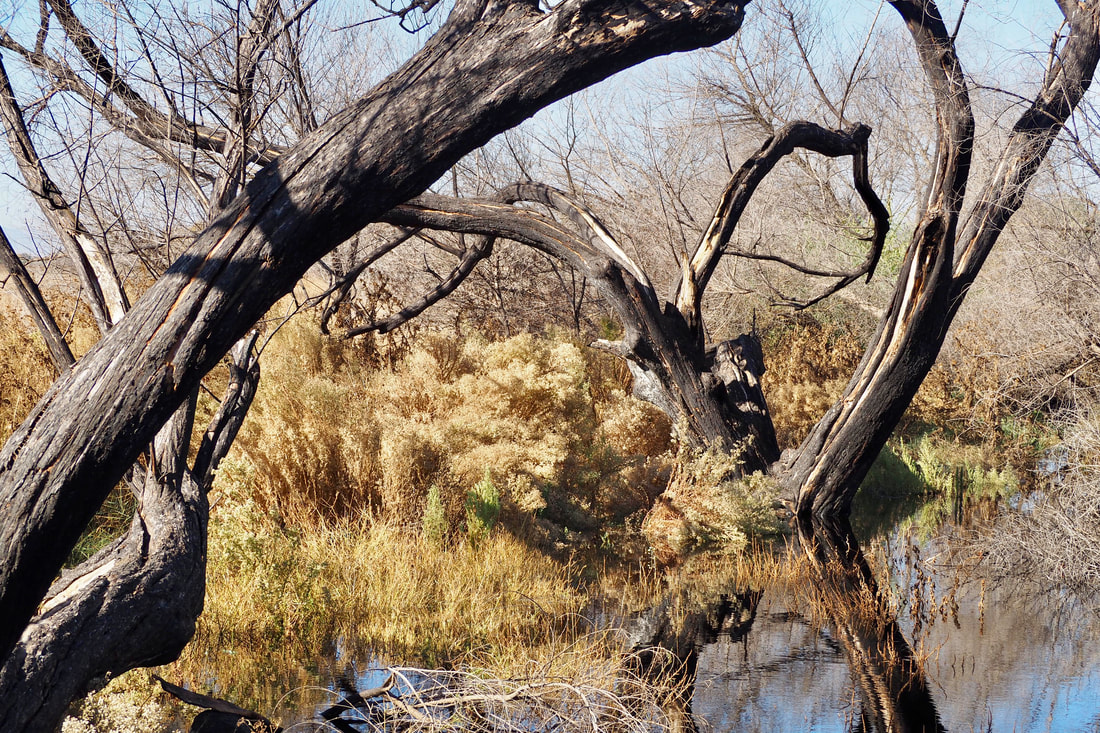General:
The San Luis National Wildlife Complex is composed of the San Luis, Merced, and San Joaquin River National Wildlife Refuges and the Grasslands Wildlife Management Area. The total area that is directly protected by the Complex is nearly 45,000 acres; an additional 90,000 acres of conservation easement is indirectly managed by the U.S. Fish and Wildlife Service to protect and benefit wildlife. This land, a mosaic of wetlands, grasslands, and riparian habitats, is part of the Pacific Flyway, a major route for migrating birds. The Complex and neighboring lands feature the largest network of freshwater wetlands remaining in California. Visitors can view and photograph wildlife and nature, including Tule Elk (link, for San Luis Wildlife Observation Brochure). The most accessible overview that I can find on the entire complex is in the General Brochure (link).
Maps:
|
San Luis National Wildlife Refuge: (link)
With its riparian woodland and native grasslands, this refuge has a great variety of birds and a high concentration of ducks, as well as a thriving herd of Tule Elk, a species that was once in grave danger of extinction (link). The complex's Visitor Center is located in this refuge. The refuge has three auto tour routes with associated nature trails (two near the Visitor Center and one in the West Bear Creek Unit). Near the Visitor's Center, the Waterfowl Auto Tour route (8.5 miles) takes you through seasonal wetlands where you may see large concentrations of waterfowl, shorebirds, and other waterbirds. The Tule Elk Auto Tour route (5 miles) includes interpretive panels to tell the story of this unique subspecies, endemic to California, that nearly went extinct in the late 1800s. Elk are visible throughout the year. There are two nature trails that launch from the Visitor Center: the Upland Trail (.5 mi.) and the Wetland/Riparian Trail (1 mi.). |
|
Three additional trails are situated along the auto tour routes. The Chester Marsh Trail (1 mi.) takes you to a historic ferry crossing on the San Joaquin River. It is open from February 15 through September 15. The Sousa Marsh Trail (1 mi.) includes an elevated observation platform overlooking one of the largest wetlands on the refuge, with spectacular waterbird viewing fall through spring. The Winton Marsh Trail (.5 mi.) meanders around a permanent wetland, and it has an elevated observation platform.
The Kesterson Unit of San Luis NWR: This unit has vernal pools that start to dry up in March and April as wildflowers bloom on their edges and in the shallows. The unit is home to a unique community of plants and animals adapted to its alkaline soils, and it offers “free-roam” nature hiking throughout. It is only open to the general public from February 15 through September 15. |
|
The West Bear Creek Unit of San Luis NWR:
The West Bear Creek Auto Tour route (2.5 mi.) winds through and around a rich mosaic of riparian woodlands, seasonal wetlands, and native grasslands, where you may see scores of waterfowl and other wildlife. The Raccoon Marsh Trail (1.3 mi.) and the Woody Pond Trail (1.75 mi.) offer opportunities to see waterbirds in fall through spring, and native songbirds and mammals during the dry summer months. This unit also has interesting vernal pools in the spring months (especially March and April). San Joaquin River National Wildlife Refuge: (link)
The Pelican Nature Trail (4 mi.) meanders through seasonal wetlands, restored riparian woodlands, and stands of old-growth valley oak trees. The trailhead includes an educational seven-acre native vegetation free-roam exploration area that is home to the rare Riparian brush rabbit. The Beckwith observation platform is open October through March, and overlooks refuge agricultural fields and grasslands that provide forage for thousands of Aleutian cackling geese and lesser Sandhill cranes. |
|
Merced National Wildlife Refuge: (link)
The Merced Auto Tour route (5 mi.): loops around seasonal wetlands and upland grasslands for views of thousands of Ross’ geese and lesser Sandhill cranes during the fall and winter, along with a diverse concentration of dabbling ducks and shorebirds. The Meadowlark Trail (1.5 mi.) is the longest loop in this refuge. The Bittern Marsh Trail (1 mi.) is a serene tree-lined loop around a permanent wetland where you may see and hear marsh birds and the occasional great-horned owl. The Kestrel Trail (.5 mi.) is a short grassland loop, home to many different songbirds that are very vocal during the spring nesting season. Various raptor species are visible in the nearby native cottonwood trees. On the north side of the refuge, the Cottonwood Trail (1.5 mi.) trail meanders through a dense stand of trees and terminates at an elevated observation platform with excellent views of geese and cranes from fall through early spring. Additional vernal pools can be viewed at the Arena Plains and Snobird Units of the Merced NWR. |
Grasslands Wildlife Management Area: (link)
Unlike typical National Wildlife Refuges, the Grasslands WMA is comprised entirely of privately-owned lands on which perpetual conservation easements have been purchased. These easements preserve wetland and grassland habitats, as well as some wildlife-friendly agricultural lands. The preservation of these areas prevents conversion of the land to uses not compatible with migratory bird and other wildlife values, while allowing daily management to remain under the landowners’ control.
Unlike typical National Wildlife Refuges, the Grasslands WMA is comprised entirely of privately-owned lands on which perpetual conservation easements have been purchased. These easements preserve wetland and grassland habitats, as well as some wildlife-friendly agricultural lands. The preservation of these areas prevents conversion of the land to uses not compatible with migratory bird and other wildlife values, while allowing daily management to remain under the landowners’ control.
Refuges and units visited:
I have only begun to scratch the surface in this complex. So far, here are the units I have visited (click on photos):









